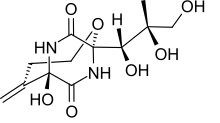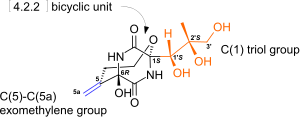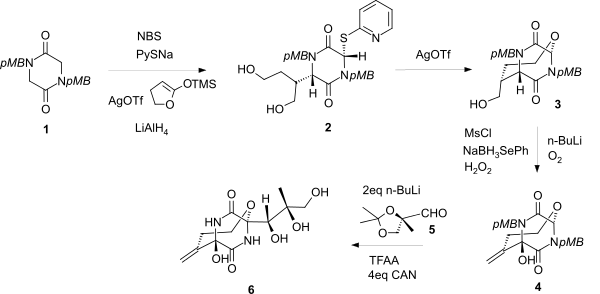Bicyclomycin
Bicyclomycin (Bicozamycin) is a broad spectrum antibiotic active against Gram-negative bacteria and the Gram-positive bacterium, Micrococcus luteus that was isolated[1][2] from Streptomyces sapporonesis and Streptomyces aizumenses in 1972. It belongs to a class of naturally occurring 2,5-diketopiperazines,[3] that are among the most numerous of all the naturally occurring peptide antibiotics. This clinically useful antibiotic is rapidly absorbed in humans when given intramuscularly, has low toxicity and has been used to treat diarrhea in humans and bacterial diarrhea in calves and pigs.[4]
 | |
| Clinical data | |
|---|---|
| Trade names | bicozamycin |
| ATC code |
|
| Identifiers | |
| |
| CAS Number | |
| PubChem CID | |
| ChemSpider | |
| UNII | |
| KEGG | |
| ChEBI | |
| Chemical and physical data | |
| Formula | C12H18N2O7 |
| Molar mass | 302.283 g·mol−1 |
| 3D model (JSmol) | |
| |
| |
Mechanism of action
Bicyclomycin is the only known selective inhibitor of Rho, a RecA-type ATPase, which is a transcription termination factor in Escherichia coli. X-ray crystallographic images of the bicyclomycin-rho complex have been used to define the rho antibiotic-binding site and understand the molecular basis for its mode of action.[4]
Physical properties
Bicyclomycin is a crystalline, colorless, water-soluble, and weakly basic substance (mp 187-189 oC) that is soluble in methanol, and sparingly in ethanol, is practically insoluble in most organic solvents, and is unstable in alkaline solution.[5]
Structure–activity relationships and Antibiotic potency

In an attempt to increase the potency and its antimicrobial spectrum, a series of synthetic and semisynthetic derivatives were investigated. Structure–activity relationship (SAR) studies have shown that the C(1) triol and the [4.2.2]-bicyclic ring were essential for bicyclomycin-rho inhibitory activity whereas the C(5)−C(5a) exomethylene moiety was not.[4] Further SAR studies[6][7] showed that 5a-substituted derivatives can be prepared that were an order of magnitude more efficient than bicyclomycin in the inhibition of rho. Bicyclomycin is considered a weak antibiotic[5] and when used alone, bicyclomycin failed to rapidly kill growing cultures of Escherichia coli; however, the additional presence of bacteriostatic concentrations of inhibitors of gene expression such as tetracycline, chloramphenicol or rifampicin led to rapid killing.[8] This lethal synergy has been considered as one way to address the growing problem of antimicrobial resistance.
Synthesis
Bicyclomycin, initially produced on large scale from the fermentation harvest of an improved strain of S. sapporonensis,[5] has also been synthesised; many derivatives have also been prepared.[5] Most of the synthetic approaches to bicyclomycin have started with a preformed 2,5-diketopiperazine.[5]

Williams synthesis[9] starts from the para-methoxybenzyl protected 2,5-diketopiperazine 1, bis bromination to give the 3,6-dibromide followed by thiolate displacements with sodio-2-thiopyridine gave the syn di(thiopyridine) derivative which was condensed with the silyl ketene acetal of y-butyrolactone in presence of silver triflate (AgOTf) to give the mono lactone which upon reduction with LiAlH4 afforded the diol 2. Cyclization of 2 in the presence of silver triflate gave the bicyclo-[4.2.2] alcohol 3. Dehydration to the key olefin proceeded in good overall yield followed by bridgehead carbanion oxidation with molecular oxygen gave the single hydroxylation product 4. Formation of the dianion of 4 followed by aldol reaction with acetal aldehyde 5 gave the aldol product with the desired relative configuration. Protection of the C-1'-hydroxyl as the corresponding trifluoroacetate followed by cleavage of the acetonide and p-methoxybenzyl groups with ceric ammonium nitrate followed by methanolysis on silica gel gave racemic bicyclomycin 6. Use of the optically active aldehyde analogue of 5 allowed preparation of optically active 6.
References
- Miyoshi T, Miyairi N, Aoki H, Kohsaka M, Sakai HI, Imanaka H (1972). "Bicyclomycin, a new antibiotic". The Journal of Antibiotics. 25 (10): 569–575. doi:10.7164/antibiotics.25.569. PMID 4648311.
- Miyamura S; Ogasawara N; Otsuka H; Niwayama S; Tanaka H; Take T; Uchiyama T; Ochiai H; Abe K; Koizumi K; Asao K. Matsuki K; Hoshino T (1972). "Antibiotic No. 5879, a new water-soluble antibiotic against gram-negative bacteria". The Journal of Antibiotics. 25 (10): 610–612. doi:10.7164/antibiotics.25.610. PMID 4648315.
- Borthwick AD (2012). "2,5-Diketopiperazines: Synthesis, Reactions, Medicinal Chemistry, and Bioactive Natural Products". Chemical Reviews. 112 (7): 3641–3716. doi:10.1021/cr200398y. PMID 22575049.
- Kohn H, Widger W (September 2005). "The molecular basis for the mode of action of bicyclomycin". Current Drug Targets. Infectious Disorders. 5 (3): 273–295. doi:10.2174/1568005054880136. PMID 16181146.
- Williams RM, Durham CA (May 1988). "Bicyclomycin: Synthetic, mechanistic, and biological studies". Chemical Reviews. 88 (3): 511–540. doi:10.1021/cr00085a004.
- Brogan AP, Widger WR, Bensadek D, Riba-Garcia I, Gaskell SJ, Kohn H (March 2005). "Development of a technique to determine bicyclomycin-rho binding and stoichiometry by isothermal titration calorimetry and mass spectrometry". Journal of the American Chemical Society. 127 (8): 2741–2751. doi:10.1021/ja046441q. PMID 15725032.
- Park BS, Widger W, Kohn H (January 2006). "Fluorine-substituted dihydrobicyclomycins: Synthesis and biochemical and biological properties". Bioorganic & Medicinal Chemistry. 14 (1): 41–61. doi:10.1016/j.bmc.2005.07.075. PMID 16185879.
- Malik M, Li L, Zhao X, Kerns RJ, Berger JM, Drlica K (July 2014). "Lethal synergy involving bicyclomycin: an approach for reviving old antibiotics". Journal of Antimicrobial Chemotherapy. 69 (12): 3227–3235. doi:10.1093/jac/dku285. PMC 4228776. PMID 25085655.
- Williams RM, Armstrong RW, Dung JS (May 1985). "Stereocontrolled total synthesis of (.+-.)-and (+)-bicyclomycin". Journal of the American Chemical Society. 107 (11): 3253–326. doi:10.1021/ja00297a035.